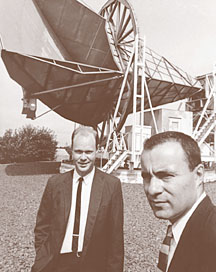
1965-1975: Closing the Circle
by Hans Christian von Baeyer
 Arno Penzias and Robert Wilson Photo courtesy of AIP Niels Bohr Library |
Even as the Vietnam War was tearing at the fabric of America, the Beatles conquered the world, and the first astronauts landed on the moon, two unrelated discoveries on opposite coasts of the country announced the opening of a new chapter in the history of physics. At the Bell Telephone Laboratories in New Jersey, Arno Penzias and Robert Wilson (right) were annoyed by a persistent hissing noise in their sensitive microwave receiver. Unable to suppress it no matter what they tried, they tracked it back to its surprising source: the cosmic background of microwave radiation that has been gradually cooling off since the Big Bang to a temperature of about three kelvins. This astonishing observation reinvigorated research on cosmology, with General Relativity as its firm theoretical backbone.
Four years later Jerome Friedman, Henry Kendall, and Richard Taylor, working at the Stanford Linear Accelerator Center in California, found the first experimental evidence for the existence of quarks, which had been proposed on theoretical grounds earlier in the decade. Protons and neutrons, it now appeared, are not elementary like photons and electrons, but composed of quarks. Here at last was reason for hope that a fundamental theory, as compelling as Quantum Electrodynamics, might one day be constructed for nuclear physics.
On the face of it, the discoveries of the cosmic background and of quarks seem to take place at opposite ends of the scale of distances. Indeed, the size of the observable universe is about forty-five powers of ten larger than that of a quark. Nevertheless, the two realms turn out to be closely related. The cosmic background radiation provides evidence of the universe the way it was about 1010 years ago, before it had expanded to its present size. A fraction of a second after the Big Bang, its particles were packed tighter than they are in an atom, so it was ruled by quantum mechanics. At one time, furthermore, the universe consisted not of atoms but of quarks. In this way cosmology brings the physics of the immensely large back to join the physics of the immeasurably small.
The scope of modern physics may be symbolized by a circle that extends from quarks, past atoms, molecules, and boulders, past planets, stars, and galaxies, out to the universe and, via the Big Bang, back to its elementary building blocks. Cosmology also relates how the universe has evolved in time. When this story is combined with stellar evolution and the geological history of the planet, with biological and cultural evolution, and finally with recorded history, a coherent narrative of truly epic proportions emerges. To be sure, the story is riddled with gaps and puzzles - including the mystery of the origin of life - but its broad outlines are firmly in place.
In the 1960s physicists first began to draft the opening chapters of this story. Future generations may well look back on this ambitious undertaking as the principal accomplishment of physics in the twentieth century.
Editor's Note: A CENTURY OF PHYSICS, a dramatic illustrated timeline wallchart of over a hundred entries on eleven large posters is intended for high schools and colleges. Each poster covers about a decade and is introduced by a thumbnail essay to provide a glimpse of the historical and scientific context of the time. A Century of Physics will be on display at the Atlanta Centennial Meeting in March.
In the December issue, APS News will feature the ninth introductory essay: 1975-1985: Images.
©1995 - 2024, AMERICAN PHYSICAL SOCIETY
APS encourages the redistribution of the materials included in this newspaper provided that attribution to the source is noted and the materials are not truncated or changed.
November 1998 (Volume 7, Number 10)
Articles in this Issue

